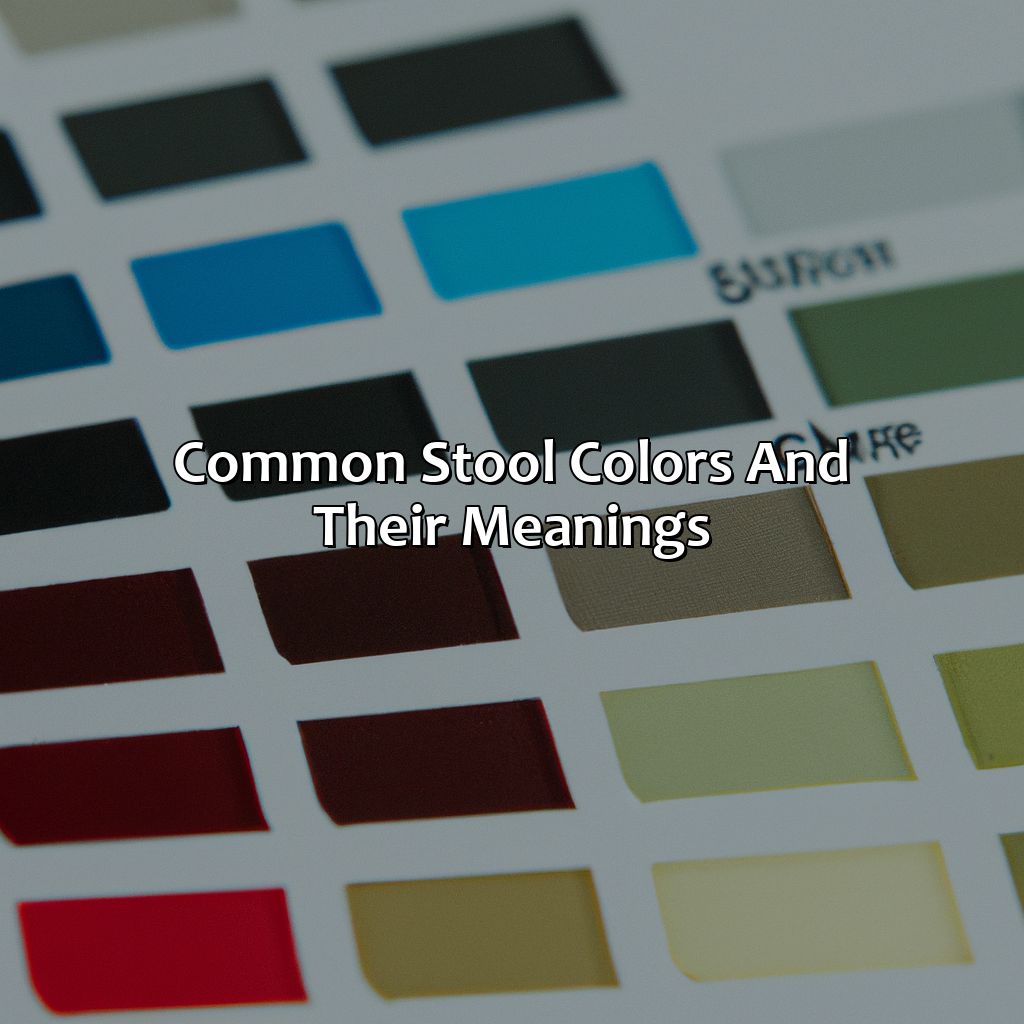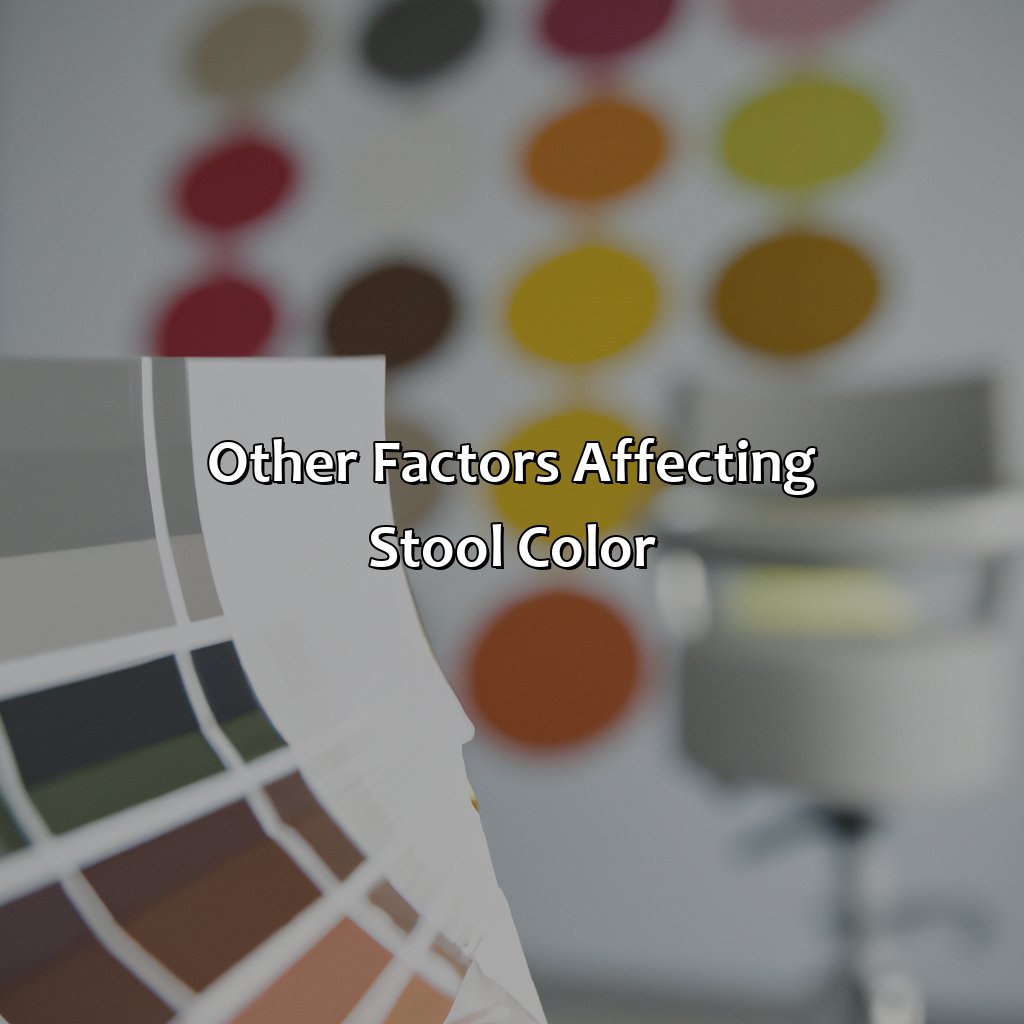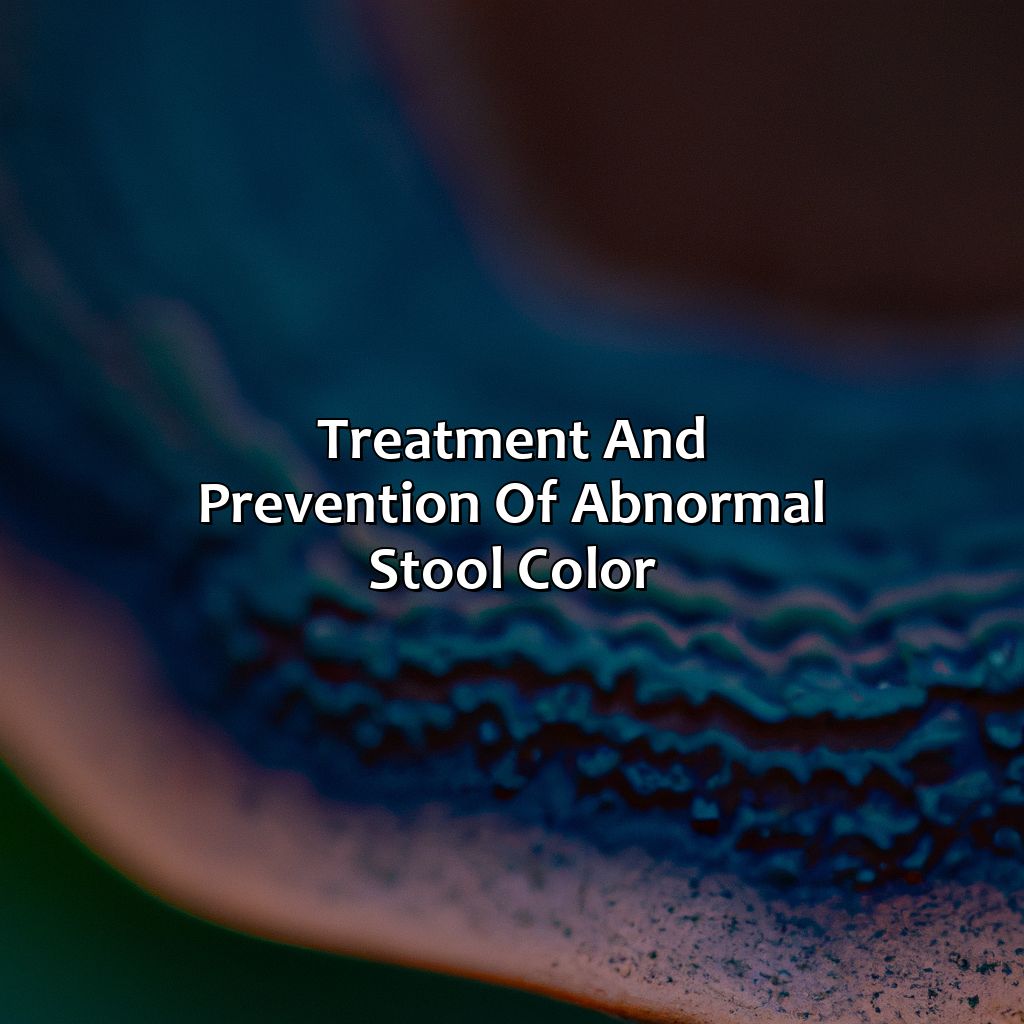Key Takeaway:
- The color of your stools is an important indicator of your digestive health. Use a stool color chart to monitor your bowel movements and identify any potential gastrointestinal issues or liver function problems.
- Common stool colors include brown, yellow, green, black, red, white, orange, and clay-colored. Abnormal stool colors such as red and black may indicate rectal bleeding or colon cancer, whereas yellow and green stools may signal liver function and bile production issues.
- Other factors affecting stool color include medications and supplements, diet and hydration, and medical conditions. It’s important to seek medical attention if you experience abdominal pain or rectal bleeding.
Understanding the Importance of Stool Color

Photo Credits: colorscombo.com by Benjamin Anderson
Stool color is crucial in determining digestive health, liver function, and bile production. The color of your stools can give insights into other possible gastrointestinal issues. Understanding the significance of stool color charts can provide early detection of health problems. Dark or black stools can indicate serious issues like internal bleeding, while pale stools can be indicative of liver diseases. It is essential to take note of stool color changes and consult your doctor promptly. Remember that your stool color can be a potential tool in diagnosing ailments, so don’t ignore it.
Common Stool Colors and Their Meanings

Photo Credits: colorscombo.com by Ryan Scott
Attention to the hue of your poop is key to understanding your digestive health. Common stool colors and their meanings can help you spot any abnormal changes. Here, we’ll discuss what yellow/orange, green, black, red, white, and clay-colored stools say about your body. We’ll look into what each color means and their potential causes in the sections below:
- Yellow/Orange Stool
- Green Stool
- Brown Stool
- Black Stool
- Red Stool
- Grey/Clay-Colored Stool
Yellow/Orange Stool
Stool color can provide valuable insights into your digestive health. Yellow/orange stool suggests a decrease in liver function or inadequate bile production, resulting in poorly digested fats. Medications and supplements containing beta-carotene or carotenoids can also cause this color. Evaluating the frequency and duration of yellow/orange stool helps diagnose underlying conditions like hepatitis or cirrhosis.
Additionally, other symptoms may accompany yellow/orange stool such as abdominal pain, fatigue, nausea, jaundice, and dark urine. It is important to note that bowel movement color varies depending on diet and hydration levels but persistent abnormal stool color warrants medical attention.
To prevent yellow/orange stool, drink plenty of water and avoid alcohol as it interferes with liver function. Eating whole foods rich in fiber promotes gastrointestinal health.
Don’t ignore any warning signs related to gut health. Consult your doctor for routine screening tests such as colonoscopy or blood tests to maintain optimal health and detect any early signs of disease.
Green stool is proof that your digestive system is moving so fast, it doesn’t have time to change the color.
Green Stool
Stool that appears green may indicate quicker intestinal transit time as food moves through the gut too fast for bile to fully break down. Another cause of green stool could be an imbalance in the gut microbiome, which can negatively impact digestive health. The shade of green can vary and may suggest different causes. However, if the green color persists for more than a few days, medical attention should be sought to rule out any underlying conditions. Maintaining a healthy diet rich in fiber and drinking enough water can promote regular bowel movements and prevent abnormal stool color.
Brown is the new black when it comes to normal stool color, but let’s dive deeper into the murky world of gastrointestinal excrement.
Brown Stool
Stool color is a vital indicator of digestive health. Brown stool is the normal stool color, and it represents a healthy digestive tract. The brown hue of the feces comes from bilirubin, which is produced by the liver and broken down in the intestines.
Brown stool can indicate that food has been digested entirely and absorbed properly through the small intestine. The presence of bile is what produces the brownish tint, indicating a healthy amount of bacteria in the colon.
It’s essential to note that if your brown stool suddenly changes to another color or has bits of blood or mucus, it could be an indication of an underlying medical condition, such as gastrointestinal bleeding.
Medical history shows that ancient Egyptians used animal feces mixed with water for medicinal purposes as they believed fertilizers produced valuable therapeutic effects. However, this practice has long stopped, and high importance has been given to having regular bowel movements with a normal stool color- brownish!
Why settle for one mystery when you can have two? Black stool: is it just a bad burrito or a sign of something more sinister? #coloncancer #rectalbleeding
Black Stool
Stools that are black in color can be indicative of bleeding in the upper gastrointestinal tract. This bleeding could be caused by a variety of factors, including ulcers, tumors, or hemorrhoids. Black stool may also be a side effect of certain medications like iron supplements.
It is important to note that black stool does not necessarily always indicate rectal bleeding or colon cancer, but it should still be taken seriously and investigated further by a medical professional.
Other symptoms that may accompany black stool include abdominal pain, nausea, and vomiting. If these symptoms persist or worsen over time, seek medical attention immediately.
A patient once reported having black stool for several days and was initially dismissed as a minor digestive issue. However, after continued investigation and testing, it was discovered that they had colon cancer. Early detection and treatment significantly increase the chances of a positive outcome in cases like this one.
Why paint the town red when you can just look at your stool?
Red Stool
Stool that appears red in color can be an indication of blood in the stool, also referred to as rectal bleeding. This could be due to a range of factors such as hemorrhoids, anal fissure, inflammatory bowel disease or even more serious conditions like colon cancer. It is important to seek medical attention immediately if red stool is noticed, especially if it is accompanied by other concerning symptoms such as abdominal cramps or pain.
In addition to rectal bleeding, red stool can also be caused by consumption of certain foods such as beets or food coloring. However, it is important not to dismiss the possibility of underlying medical issues and consult a healthcare provider for further evaluation.
Pro Tip: Early detection and treatment of conditions like colon cancer can significantly increase the chances of successful recovery. Regular screening tests are recommended for those over 50 years old or those with a family history of colorectal cancer.
You know you’re in trouble when your stool looks like it could be used for pottery.
Grey/Clay-Colored Stool
Stool color may indicate underlying health issues, including grey or clay-colored stool. This unusual color occurs when there is a lack of bile in the stool, which can be a sign of pancreatic dysfunction. Bile is produced by the liver and stored in the gallbladder, where it is released into the small intestine to aid in digestion and breakdown of fats. However, if there is a blockage in the bile ducts or malfunction of the pancreas, bile may not reach the small intestine, leading to grey or clay-colored stool.
If you notice this type of stool color persisting for more than two days, it is crucial to seek medical attention promptly. Additionally, other symptoms such as abdominal pain or swelling, nausea, vomiting can indicate a severe condition and should not be ignored. Early diagnosis and treatment are essential for effective management of pancreatic dysfunction and other potential health problems that may cause grey or clay-colored stool.
Therefore, do not ignore any unusual colored stools that persist for prolonged periods without dietary or lifestyle changes since they could be indicative of serious underlying health issues. From fecal transplants to essential oils, there are many factors that can affect the color of your stool.
Other Factors Affecting Stool Color

Photo Credits: colorscombo.com by Frank Green
To grasp the various influences on your stool’s color, you need to look into:
- stool analysis
- colonoscopy
- fecal occult blood test
- stool culture
- fecal microbiota transplantation
- probiotics
- dietary changes
- hydration
- exercise
- stress management
- essential oils
- herbal remedies
- traditional medicine
- and medical interventions.
In this part, you’ll investigate how drugs and supplements, diet and hydration, and medical issues can also affect your stool’s hue.
Medications and Supplements
Certain medicinal drugs and nutritional products can lead to changes in stool color. These modifications are generally harmless, but can change the shade of feces dramatically. Over-the-counter vitamin supplements may cause bright yellow urine or even greenish stool. Antibiotics can also affect the color of feces by reducing the amount of normal bacteria in the gut, resulting in darkening or loosening of stools.
Additionally, non-steroidal anti-inflammatory medications (NSAIDs), such as ibuprofen, aspirin, and naproxen, may cause light-colored stools or even blood in stools. Iron medications may create black feces as a side effect. High doses of particular vitamins like iron and beta-carotene might cause orange-colored stool.
It is important to note that medications and supplements can also impact bowel movements, including frequency and consistency.
If you experience abnormal changes in stool coloration while taking any medication or supplement, it is critical to notify your doctor immediately as this may indicate a potentially serious condition.
To prevent adverse effects from medications and supplements that modify stool coloration, consult with your medical professional before beginning any new treatment regimen or making any significant dietary alterations. Your doctor will be able to identify which medications are causing changes in your feces color and modify your therapy accordingly.
Drink more water, or you’ll end up with a stool color that even Picasso couldn’t paint.
Diet and Hydration
The food and fluids we consume play a crucial role in the color of our stools. Inadequate hydration or dehydration can cause pale, clay-colored stools due to reduced bile production. Nutritional deficiencies caused by a poor diet can also contribute to abnormal stool color.
Additionally, consuming certain foods such as beets, blueberries, or tomatoes can turn your stool red while leafy green vegetables like spinach may cause it to be green. Overconsumption of processed foods lacking in fiber can result in dark black or tar-like stools.
To prevent abnormal stool color due to poor diet and hydration, ensure that you are drinking plenty of fluids daily and eating a well-balanced diet rich in nutrients. Incorporating high-fiber foods into your meals can promote regular bowel movements and reduce the likelihood of developing constipation.
By maintaining healthy dietary habits and staying hydrated, you can ensure that your stool stays within healthy ranges for color and consistency. In case of persistent abnormalities in stool color, it is important to seek medical advice as this may be an indication of an underlying condition.
Don’t let inflammatory bowel disease, irritable bowel syndrome, or celiac disease cramp your style – know your stool colors!
Medical Conditions
Stool color changes can be indicative of underlying medical conditions, such as inflammatory bowel disease, irritable bowel syndrome and celiac disease. In these conditions, the normal pigmentation of the stool can get altered due to inflammation in the digestive tract. The color change in stool can be accompanied by other symptoms like abdominal cramps, diarrhea, and constipation.
If an individual has persistent abnormal stool colors along with the above mentioned symptoms or any other discomfort in their gut, it is important to consult a doctor at the earliest to rule out any potential medical condition.
Pro Tip: Stool color changes are not always due to an underlying medical condition. However, if one finds any unusuality persist for more than a week even with proper hydration and diet routine, it’s time to seek physician assistance.
Feeling like you got kicked in the gut or seeing red where you shouldn’t? Time to call in the professionals.
When to Seek Medical Attention

Photo Credits: colorscombo.com by Gabriel Hill
Knowing When to Seek Medical Attention for Your Stool Color
Changes in stool color can be concerning, but when should you seek medical attention? If you experience accompanying symptoms like abdominal pain or rectal bleeding, it’s essential to seek medical attention immediately. Failure to do so could result in serious health complications.
It’s important to note that not all changes in stool color may be indicative of a health problem, but some may signal a more significant issue. Therefore, it’s crucial to be aware of accompanying symptoms and when to seek prompt medical attention.
When changes in stool color persist or are accompanied by other troubling signs, such as abdominal pain or rectal bleeding, it’s essential to seek immediate medical attention. Ignoring these symptoms could lead to serious health problems, so always trust your instincts and seek professional medical care.
Remember, it’s essential to act quickly when it comes to your health to avoid any further complications. If you’re experiencing any concerns about your stool color or other accompanying symptoms, don’t hesitate to contact your healthcare provider for further guidance.
Treatment and Prevention of Abnormal Stool Color

Photo Credits: colorscombo.com by Jeremy Nelson
Stool Color Abnormalities: Addressing the Issue Effectively
Abnormal stool color can indicate an underlying health issue. Diagnosis can involve a physical examination, blood tests or stool sample analysis. Treatment protocols can range from medical interventions to home remedies, and natural treatments to alternative medicine. Prevention involves maintaining good digestive health, following health tips and adopting a healthy lifestyle. When seeking treatment for abnormal stool color, prompt action is necessary to maintain overall health and wellness.
It is important to address stool color abnormalities promptly. The longer the symptoms are left unchecked, the greater the risk of more serious consequences. A doctor may prescribe medication or recommend dietary changes to address the underlying issue, which may lead to normalization of stool color. Natural treatments, such as consuming herbs or probiotics, may be recommended to aid in digestive health. Adopting and maintaining healthy eating habits and a healthy lifestyle can also help prevent abnormal stool colors.
It is vital to understand that every case of abnormal stool color is unique and requires personalized treatment. For instance, a woman experienced red stool, leading to panic, but further examination revealed that it was due to the consumption of red beets. Being aware of such experiences can prevent unnecessary worry.
In a recent case, a young man experienced green stool and was concerned. Medical tests revealed that the cause was a bacterial infection, and his doctor prescribed antibiotics, leading to a full recovery. Prompt medical attention was imperative in this situation.
Five Facts About What The Color Of Your Stools Mean:
- ✅ Normal stool color ranges from light to dark brown due to the presence of bile in the intestines. (Source: Medical News Today)
- ✅ Green stool can be caused by a variety of factors, including consuming certain foods or medications, or having a digestive system issue. (Source: Healthline)
- ✅ Red or black stool can indicate the presence of blood in the stool, indicating a potential issue with the digestive or gastrointestinal system. (Source: Mayo Clinic)
- ✅ White or pale-colored stool may indicate a problem with the liver or bile ducts. (Source: Harvard Health Publishing)
- ✅ Clay-colored stool can be a sign of a blockage in the bile ducts or liver disease. (Source: WebMD)
FAQs about What Does The Color Of Your Stools Mean
What does the color of your stools mean?
The color of your stools can tell a lot about your health. The color can vary from light brown to black, and each color indicates a different thing.
What does yellow stools indicate?
Yellow stools can be a sign of excess fat in your stools. This can be due to many factors, including malabsorption, celiac disease, and gallbladder problems. It can also be caused by taking certain medications, such as antibiotics.
What does green stools indicate?
Green stools can indicate that food is moving through your intestine too quickly, giving your bile no time to break down. This can be caused by many things, including eating a lot of green leafy vegetables or consuming foods with green food coloring.
What does black stools indicate?
Black stools can indicate that there is blood in your stool or that you are taking certain medications, such as iron supplements or bismuth subsalicylate. Black stools can also be caused by eating certain foods, such as licorice or blueberries.
What does red stools indicate?
Red stools can indicate that there is blood in your stool. This can be caused by many factors, including hemorrhoids, anal fissures, diverticulitis, inflammatory bowel disease, and colon cancer.
What does white or clay-colored stools indicate?
White or clay-colored stools can indicate that there is a problem with your bile flow. This can be caused by many factors, including liver disease, bile duct obstruction, gallstones, or pancreatitis.






